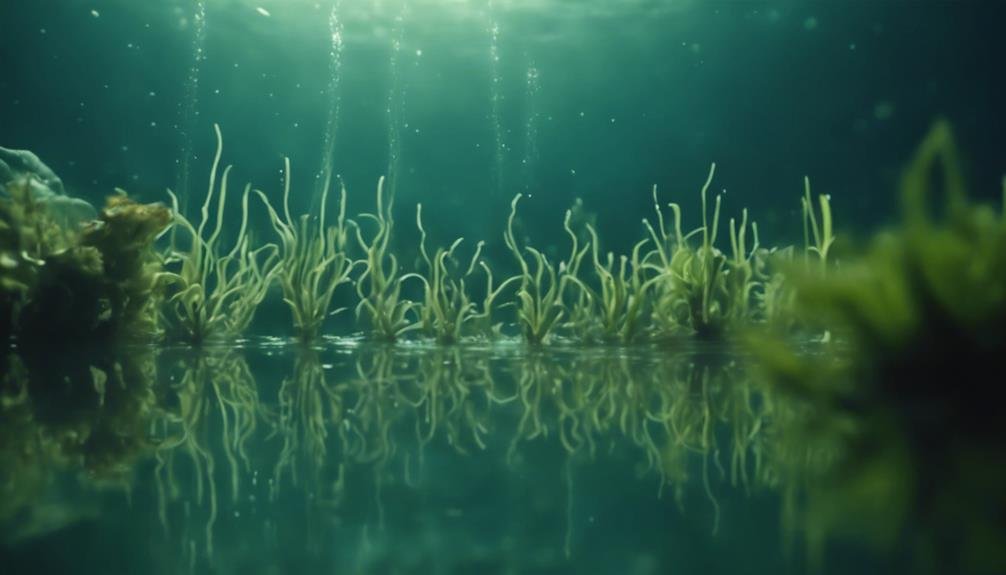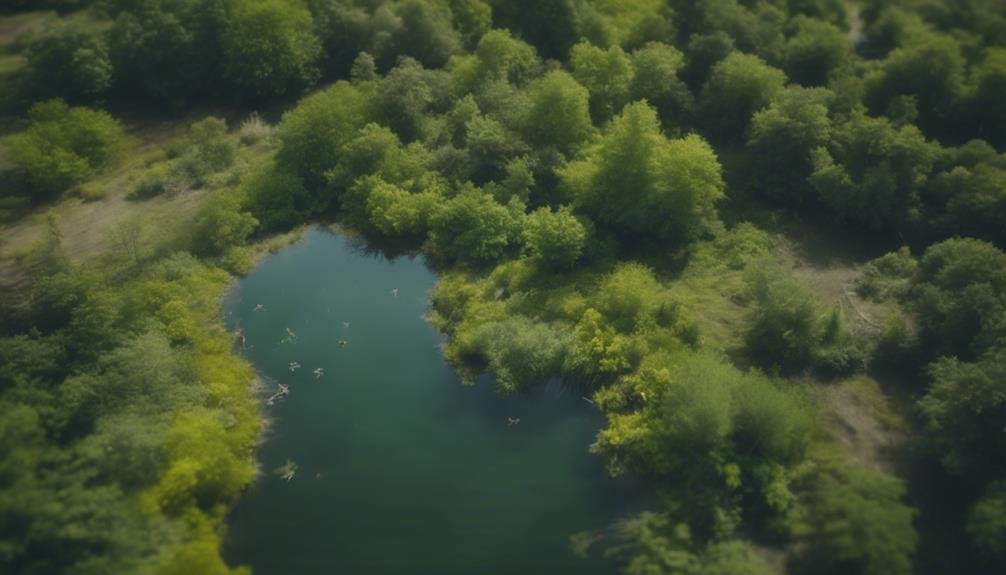To effectively detect leaks in ponds, it is recommended to use a combination of various tools. Visual inspections, dye testing, and acoustic detection methods are essential for accurately pinpointing leaks. Additionally, electronic sensors that continuously monitor water levels can provide real-time data on any fluctuations.
Pressure testing kits and compressed air techniques are valuable for isolating leak locations within plumbing systems. Moisture meters are also helpful in quickly identifying damp areas that could indicate a leak.
For larger ponds, remote sensing technologies offer aerial perspectives that can be incredibly beneficial. By utilizing a mix of these tools, you can ensure comprehensive monitoring and efficient leak detection.
Each tool serves a specific purpose and when used together, they create a thorough approach to identifying and addressing leaks in ponds. It is important to understand the specific applications and best practices for each tool to maximize their effectiveness in maintaining the integrity of your pond.
Visual Inspection Techniques
Visual inspection is a cost-effective way to detect leaks in ponds. To start, thoroughly inspect the edges and banks for any signs of water seepage, erosion, or sinkholes. These indicators could point to a leak or underground water flow issue. Keep an eye out for wet or muddy areas around the pond that seem out of place, as they may reveal leakage.
Another visual clue to watch for is unexpected aquatic plant or algae growth, which could signal a continuous water source feeding them. If the pond liner is visible, check for cracks, holes, or raised sections that could be letting water escape. Don't forget to examine any inlets or outlets for potential leaks.
Monitoring changes in water level over time can also help pinpoint leaks. If you notice a significant drop in water level without excessive evaporation or rainfall, it's likely that water is escaping abnormally.
Dye Testing Methods
Dye testing is a method that uses brightly colored, non-toxic dyes to trace leaks in pond water. By introducing the dye into the water and observing its movement, we can pinpoint the location of leaks based on where the dye exits or drains.
In larger ponds, we may use multiple dye colors simultaneously to track potential paths more accurately. It's crucial to use high-quality dyes specifically designed for this purpose to ensure precise results. Detailed notes and video footage may be taken to document the behavior of the dye thoroughly.
This method is effective for identifying leaks, especially when visual inspections aren't sufficient. However, it's most successful in ponds with consistent water levels and flow rates. Fluctuating conditions can affect the dispersal or dilution of the dye, making the testing process more complex.
With careful observation and the right dye products, dye testing can highlight potential issues for further investigation.
Acoustic Leak Detection

One effective method for leak detection involves using specialized acoustic equipment to listen for sounds created by water escaping under pressure. This approach is non-invasive and eliminates the need for draining or excavation, making it a convenient and efficient solution.
The high sensitivity of acoustic leak detection devices enables them to pinpoint even the smallest noises associated with leaks, offering precise location identification.
Acoustic leak detection presents several advantages over traditional methods. Firstly, it can accurately find leaks in large or irregularly-shaped ponds, where visual inspection may be challenging. Additionally, this technique is relatively quick and cost-effective, saving both time and resources.
By attaching sensors or hydrophones to the pond's surface, technicians can analyze the captured sounds with specialized software, allowing them to locate the leak with remarkable precision.
In cases where visual inspection or other methods fall short, acoustic leak detection serves as a valuable tool in identifying and addressing leaks promptly. This method's ability to access hard-to-reach areas and provide detailed insights into leak locations makes it a preferred choice for pond maintenance and leak detection.
Electronic Water Sensors
Let's dive into electronic water sensors, which are devices designed to detect water leaks by monitoring moisture levels or changes in electrical properties. These sensors come in various types, such as float sensors, moisture sensors, and water detection cables.
To ensure these sensors work effectively, it's crucial to consider factors like proper installation, placement, and regular testing.
Float sensors are commonly used in sump pumps and water tanks. They work by rising with the water level and triggering an alert or shutting off the water flow when a leak is detected.
Moisture sensors, on the other hand, can be placed in areas prone to leaks, like under sinks or near water heaters. These sensors react to moisture and send alerts when water is detected.
Water detection cables are flexible and can be laid out along the floor to sense leaks in larger areas.
When installing electronic water sensors, it's essential to place them in strategic locations where leaks are most likely to occur. Regular testing of these sensors is crucial to ensure they're functioning correctly and providing timely alerts in case of leaks.
Types of Sensors
Various electronic water sensors can detect leaks in ponds by monitoring water levels or detecting moisture outside the pond's boundaries. Let's explore some common types:
- Hydrostatic level sensors measure water level by assessing the pressure from the water column.
- Ultrasonic level sensors use sound waves to determine the distance to the water's surface, indirectly measuring the water level.
- Float sensors include a float that moves with the water level, triggering a switch when the level decreases below a specific point.
- Moisture sensors are placed around the pond's perimeter to identify any moisture seeping through from a leak.
Each sensor type has its pros and cons in terms of accuracy, installation ease, and cost. Hydrostatic and ultrasonic sensors offer continuous level monitoring, while float and moisture sensors only signal when levels go below a certain threshold.
Some sensors can integrate with automated systems to activate alarms or refilling mechanisms when a leak is detected. Proper installation and calibration are crucial for dependable leak detection.
Installation Considerations
Properly installing electronic water sensors for leak detection in ponds requires careful planning to ensure accurate and reliable performance. Factors such as pond layout, size, and potential leak locations must be considered to determine the best placement for sensors. Analyzing water flow patterns can help identify areas prone to leakage, guiding strategic sensor positioning.
Ensuring accessibility is crucial; sensors should be installed in easily reachable locations for maintenance and monitoring purposes. Protective housing or shielding may be necessary to safeguard sensors from environmental elements like debris, vegetation, or animals. Proper cable management and waterproofing are key to prevent water damage and maintain functionality over time.
It's important to take into account the sensor's range and detection capabilities. Depending on the model, sensors may need to be spaced closely or provide overlapping coverage to detect leaks effectively. Thorough testing and calibration post-installation are essential to confirm proper operation and make any necessary adjustments.
With meticulous planning and execution during installation, electronic water sensors can effectively detect and address pond leaks.
Maintenance Requirements
Electronic water sensors in ponds need regular maintenance to ensure accurate leak detection. To keep these sensors functioning properly, it's essential to perform routine checks and calibrations.
Here are four important maintenance tasks to follow:
- Battery replacement is crucial to prevent power loss and data interruption since many sensors operate on batteries. By replacing them periodically, you can maintain continuous functionality.
- Cleaning the sensors is necessary to prevent debris, algae, or mineral buildup that can affect their accuracy over time. Gently clean them with a soft brush or mild solution to ensure optimal performance.
- Recalibrating the sensors at regular intervals is important due to environmental factors like temperature, humidity, or water composition that may influence readings. This helps maintain precision in leak detection.
- Regularly reviewing sensor data allows you to pinpoint potential issues such as unusual readings or sudden changes. By staying vigilant and addressing any anomalies promptly, you can ensure the sensors are working effectively.
Remote Sensing Technologies

Using remote sensing technologies for leak detection in ponds involves innovative methods like aerial imagery and specialized sensors to identify potential issues from a wider perspective. Satellite imagery, drones with thermal cameras, and aircraft-mounted sensors are utilized to gather data on the pond's surface and its surroundings. These tools help in detecting temperature fluctuations, moisture levels, and changes in vegetation that could indicate a leak presence.
Analyzing the collected data allows us to pinpoint areas that require further investigation. For example, thermal imaging can highlight cooler areas on the pond's surface, hinting at possible underground water seepage. Multispectral sensors can identify changes in vegetation health, signaling excessive moisture due to a leak. Additionally, techniques such as LiDAR can generate detailed 3D models of the pond and nearby terrain to identify subtle topographical changes associated with leaks.
These remote sensing methods provide an efficient and non-intrusive means of monitoring large areas, reducing the need for extensive on-site inspections. However, combining them with ground-based assessments is essential to confirm and address any detected issues effectively.
Pressure Testing Approaches
Let's look at three different methods for pressure testing to detect leaks in ponds: pressure testing kits, compressed air techniques, and vacuum box detection.
These methods involve introducing either air or vacuum pressure into the pond lining system and then monitoring for any loss of pressure that could indicate a leak.
Pressure Testing Kits
Pressure testing kits are essential tools for detecting leaks in ponds. These kits use an air compressor and strategically placed valves to isolate different sections of the pond's plumbing system. By pressurizing individual sections and monitoring the pressure gauge for drops, potential leak sources can be pinpointed. The kit typically includes an air compressor, a pressure gauge, shut-off valves, and fittings and hoses.
The process involves closing off specific sections, applying air pressure, and observing the gauge reading over time. If the pressure remains constant, that section is likely leak-free. However, if the pressure drops, it indicates a leak within that isolated area, guiding further investigation and repair. This systematic approach ensures a thorough inspection of the entire pond system, facilitating targeted repairs and minimizing water loss.
Pressure testing kits offer a practical and efficient way to identify leaks, providing valuable information for maintaining the pond's integrity. By carefully following the testing process, pond owners can address leaks promptly and prevent further damage. Investing in a pressure testing kit can save time and resources in the long run by addressing issues before they escalate.
Compressed Air Methods
Using compressed air methods involves utilizing specialized equipment and precise techniques to assess a pond's plumbing system thoroughly. The process begins by introducing compressed air into the plumbing, creating pressure within the system. By carefully monitoring pressure levels and listening for any hissing sounds that may indicate leaks, we can identify potential issues.
State-of-the-art air compressors and accurate gauges ensure that we obtain precise pressure readings, making it easier to detect even the smallest leaks in the system. To enhance leak detection, we may use underwater microphones or hydrophones to amplify faint noises. Additionally, the introduction of special dyes or smoke can help visually highlight any escaping air bubbles, aiding in the identification of leaks.
This meticulous approach allows us to pinpoint the exact locations of leaks, whether they're in pipes, liners, or other components of the pond. By creating detailed maps of leak locations, we can develop targeted repair plans, ultimately saving both time and resources.
Vacuum Box Detection
In addition to compressor-based methods, we utilize vacuum box detection to inspect pond liners for potential leaks. This technique involves placing a transparent box with an open bottom on the liner and creating a vacuum inside. If the liner is intact, the vacuum will remain stable. However, if there's a leak, air will be drawn through the breach, allowing us to identify its precise location.
Vacuum box detection is especially useful for pinpointing small punctures or tears that may be missed by other methods, efficiently examining large liner areas, checking hidden or inaccessible spots, and verifying the integrity of new installations or repairs.
Before conducting the vacuum test, we meticulously clean the liner surface to ensure accurate assessment and timely resolution of any issues. This meticulous process helps maintain the pond's water-holding capacity, preventing future damage and costly repairs.
Moisture Detection Tools

Moisture detection tools are essential for pinpointing leaks in ponds. By measuring the moisture content in the soil surrounding the pond, these tools help identify areas where water is escaping.
There are two main types of moisture detection tools commonly used: moisture meters and leak detection cameras.
Moisture meters are handheld devices that use probes inserted into the ground to measure soil moisture levels. Higher readings indicate the presence of a leak in that specific area. These meters are user-friendly and provide immediate results, making them ideal for DIY leak detection efforts.
On the other hand, leak detection cameras utilize advanced infrared technology to detect temperature differences caused by moisture. As water escapes, it cools the surrounding soil, creating a visible temperature contrast through the camera's lens. These cameras offer a more comprehensive view, allowing for quick scanning of large areas to identify potential leaks efficiently.
Both moisture meters and leak detection cameras are cost-effective and easy to use. By incorporating these tools into regular pond maintenance routines, leaks can be promptly addressed before they result in significant water loss or structural damage.
Conclusion
To find leaks in our pond, we'll use a mix of visual checks and electronic sensors. By looking for discolored areas near the pond, we can spot signs of water loss.
Additionally, installing soil moisture sensors will help us locate the exact areas of leaks. By combining these methods, we can quickly identify any issues, make timely repairs, and conserve water effectively.

